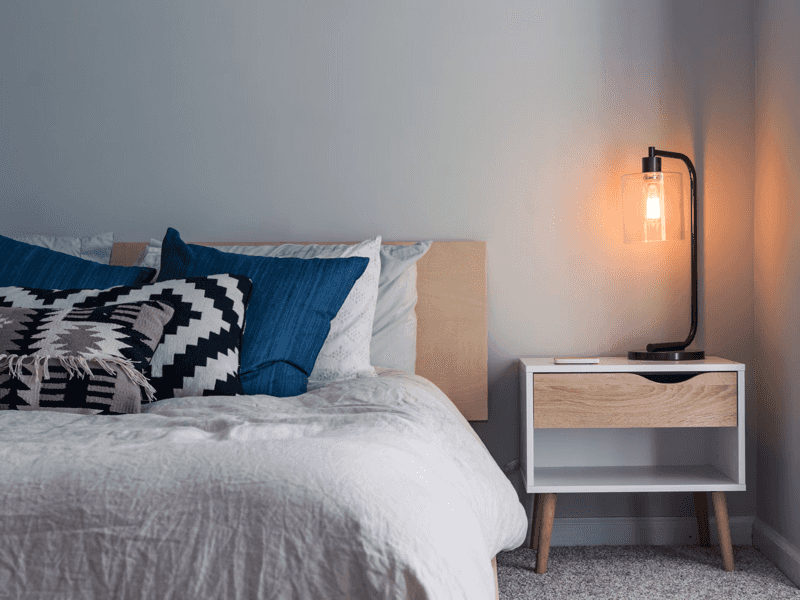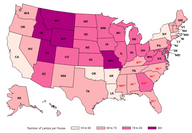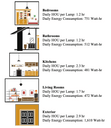How Much Can You Save by Switching to LED Lighting?

Table of contents
How to calculate the energy and cost savings of LED lights
Energy use of light bulbs across the U.S.
Energy use of light bulbs in each room of the house
How to calculate your potential savings
How bulb lifespans affect costs and savings
Read more about LEDs and home energy efficiency improvement projects
In this article we’ll help you estimate how much you can save by switching from incandescent or CFL lights to LEDs. To learn how to choose LEDs or decide if they are right for your home, check out our LED lighting buyer’s guide. And if you’re unsure if LEDs will be the right color, check out our LED color and temperature guide.
But for now, let’s chat dollars and cents and answer one question: how much can you save with LEDs?
How to calculate the energy and cost savings of LED lights
The average home with incandescent bulbs uses about 2,000 kWh of electricity per year.
At the national average of $0.10 per kWh, these homeowners spend $215 a year on lighting. By switching to LEDs, you can save around $4,000 over 20 years (the typical lifespan of an LED). As far as energy efficiency projects go, that’s a lot!
To put that in perspective, consider that switching to a heat pump water heater (another great savings opportunity) will save you about $200 per year and $5,000 over its 15-20 year lifespan. And switching to a heat pump (for heating and cooling), can save you as much as $1,000 per year and $15-20k over its lifespan.
If you want to calculate exactly how much you’ll save, you need to base it on everything from your location to how big your house is to what kinds of lights you’re currently using. Here, we’ll walk through some averages and calculations to help you get a more realistic number for your personal use case.
Energy use of light bulbs across the U.S.
As you can see in the map below, the number of bulbs per house varies depending on where you live. Across the United States, the average number of light bulbs per house ranges from about 50 to 80, according to the Pacific Northwest National Laboratory.
Of course, if your home is bigger than the national average—about 2,000 square feet—then you’ll likely have more bulbs. And vice versa.
And if you want an exact figure, you can count how many bulbs are in your house. But if you’re way over or under the average, it might be time for a lighting redesign to get you closer to what most people are using.
Energy use of light bulbs in each room of the house
The next factor to consider is how much you use your lights. Here’s a chart with all the data you need to make a good estimate of that.
Note: in the image, HOU stands for hours of use.
As you can see, most homeowners use their lights between 1 and 3 hours per day on average.
How to calculate your potential savings
People talk about electricity in the home in terms of kilowatt hours (kWh); as in, the average home uses 10,000 kWh of electricity per year. But if you look at a light bulb package, you’ll notice it gives you the energy used in watts (e.g., a 60W bulb). So how do you turn watts into kilowatt hours?
You can use the following equation to calculate the energy used by lighting in your home:
If you’re like me, math might not be your forte. So let’s go over an example to show how that equation works:
- That 60W on the package means that your light bulb uses 60 watts of energy every hour that it’s on. That’s equivalent to .06 kWh (60W / 1000 = 0.06 kWh).
- That means that a 60W light bulb used for 2 hours per day uses 43,800 watts of electricity or 43.8 kWh every year (0.06 kWh * 2h * 365d = 43.8 kWh/year).
- So if you have 50 light bulbs that use that much energy in your home, that means you use 2,190 kWh of electricity every year on lighting (50 * 43.8 kWh = 2,190 kWh)
Once you have the total yearly electricity use, you can multiply that by your average yearly electricity rate to find how much it costs to light your home. At the national average electricity rate of $0.10, we’re looking at $219 per year spent on lighting ($0.10/kWh * 2,190 kWh = $219).
To get an even more precise estimate of your savings (which honestly, might be overkill), you’ll also want to think about lumens.
For a detailed understanding of watts vs. lumens, take a look at our guide to LED lights. But for our purposes here, just know that although watts and lumens measure different things, the general conversion is 60W incandescent bulb = 800lm LED bulb. So if we’re following the same example as above, here’s what it would look like.
- LEDs that create 800lm of light use 10W of energy, or 0.01 kWh (10W / 1000 = 0.01 kWh).
- A 10W LED bulb that is used 2 hours per day uses 7,300 watts or 7.3 kWh per year (0.01 kWh * 2h * 365d = 7.3 kWh/year).
- A home with 50 lights used for that amount on average would use 365 kWh per year (50 * 7.3 kWh = 365 kWh).
Meaning if you had the national average electricity rate of $0.10 per kWh, you would spend $36.50 per year on electricity for lighting. This gives you a savings of $178.50 from the existing lights—over $6,000 throughout the course of home ownership—just from just the electricity savings.
But that’s not the only savings LEDs can give you.
If you’re replacing compact fluorescent lights (CFL) and not incandescents, the math is different. A CFL bulb with a brightness of 800lm has an energy use of 14W and a lifespan of 8,000 hours. Using the process above (with the assumption that all of the light bulbs in the home are CFLs), the average yearly electricity cost of lighting would be $51.10. Take a look at our guide to LEDs for more information.
How bulb lifespans affect costs and savings
Existing light bulbs, called incandescents, last for 1,200 hours on average. That means that if you use your bulb for 2 hours a day, you’d have to replace your bulb every 1.64 years. On average, you’re looking at spending $30 a year just on the light bulbs themselves.
LED light bulbs have lifespans of more like 25,000 hours. If you use it for 2 hours a day, you would only have to replace the LED once every 34.25 years—so basically never.
Over the course of those 34.25 years, you’d have spent over $1,000 on incandescents.
Read more about LEDs and home energy efficiency improvement projects
Table of contents
How to calculate the energy and cost savings of LED lights
Energy use of light bulbs across the U.S.
Energy use of light bulbs in each room of the house
How to calculate your potential savings
How bulb lifespans affect costs and savings
Read more about LEDs and home energy efficiency improvement projects



